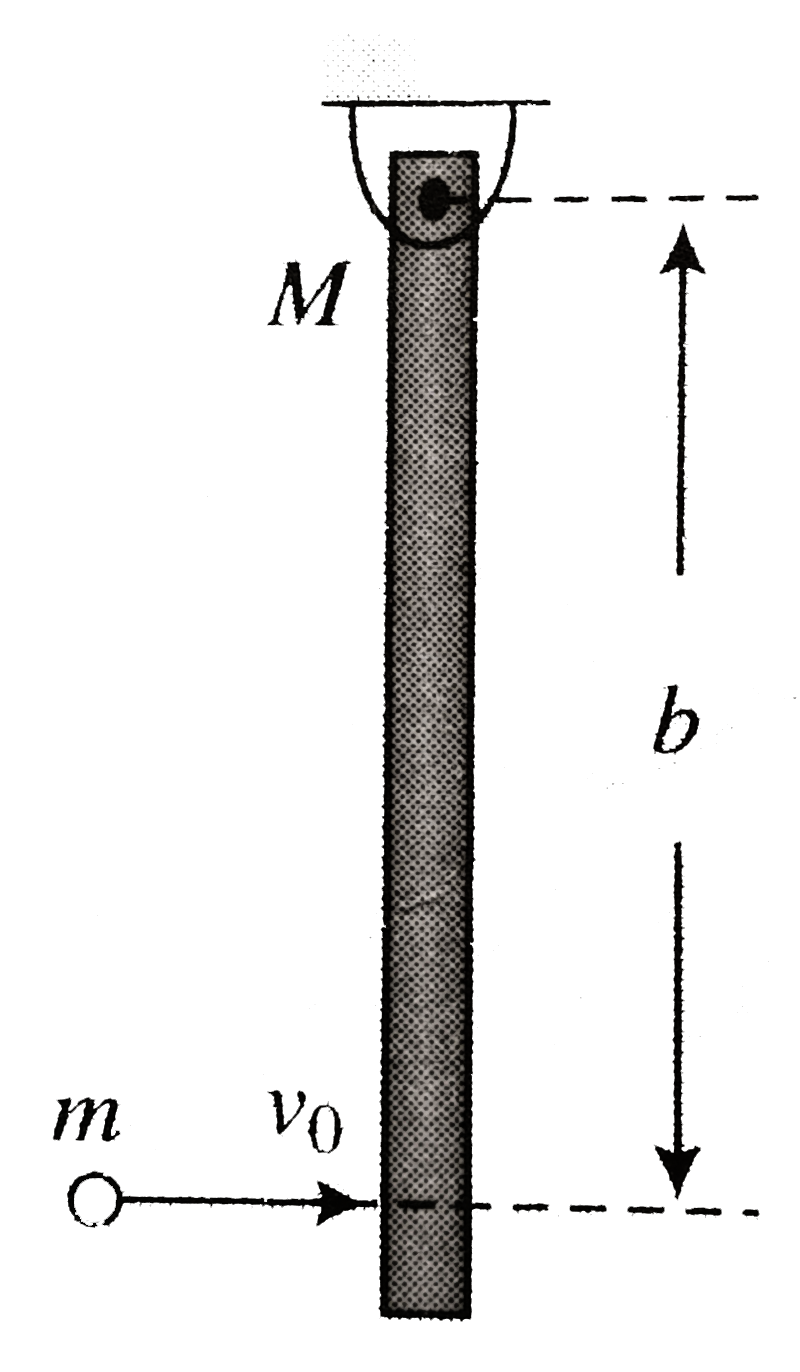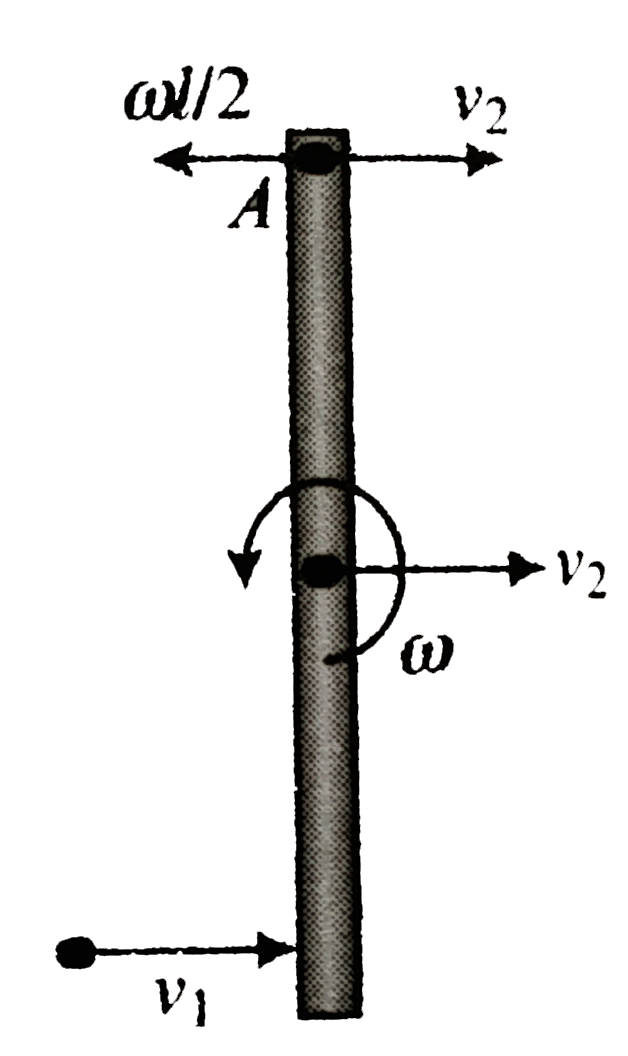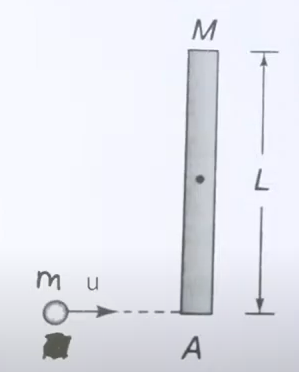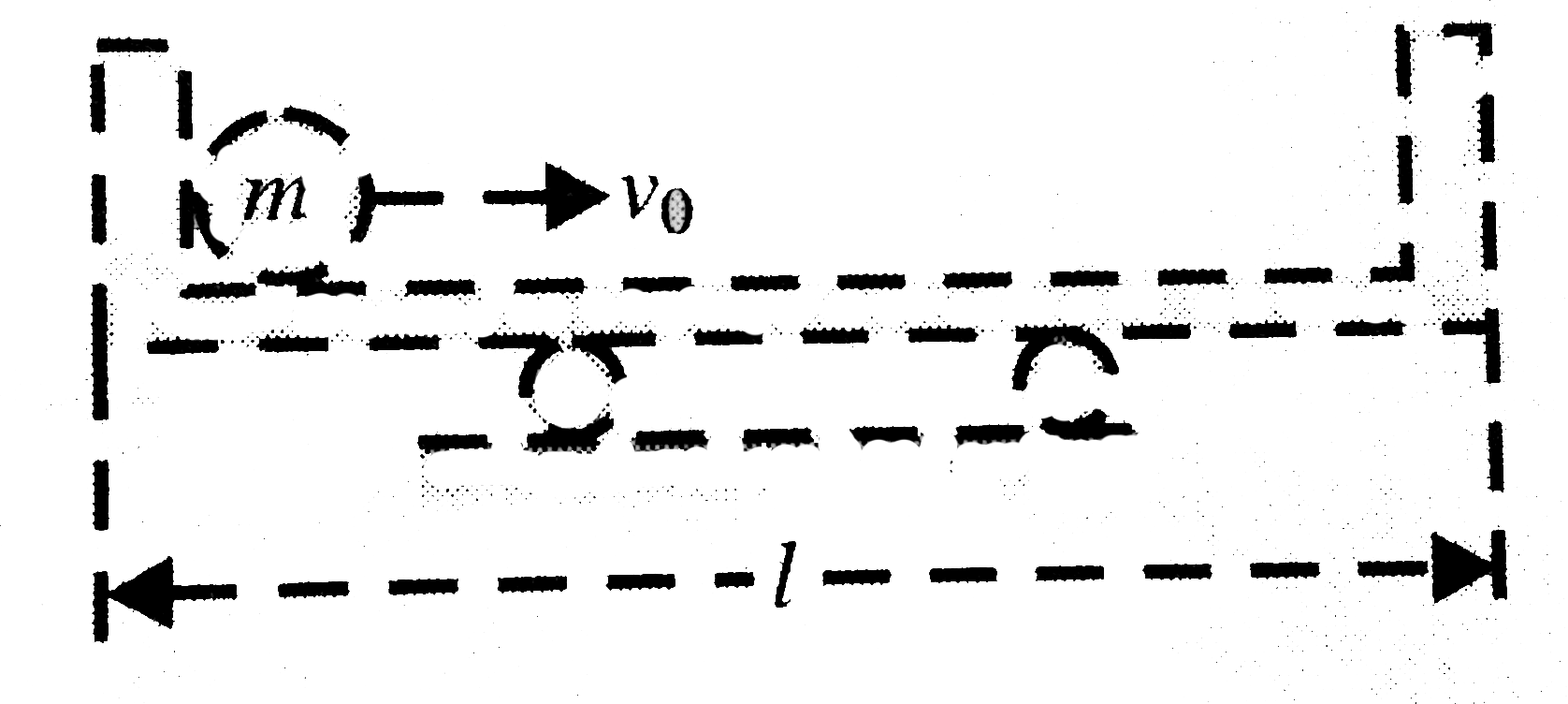A ball of mass m collides elastically with a smooth hanging rod of mass M and length l.
a. If M=3m find the value of b for which no horizontal reaction occurs at the pivot.
b. For what value of m/M the ball falls dead just after the collision assuming e=(12)?

As no horizontal reaction occur at pivot end hence their is no impulsle on the system horizontal direction. We can use conservation linear momentum just before collision and just after collision in horizontal directioin. Let the velocities of particle and rod just after collisionis v1 and v2 respectively.
mv0=mv1+3mv2
v0=v1+3v2.....i
Now applying conservation of angular momentum about pivot end just before collision and just after colision. Let angular velocity of the rod about pivot end is ω.
mv0.b=mv1.b+3ml23ω
v0=v1+ωl2b.......ii
From i and ii 3v2=ωl2b........iii
For no impulse at end vA=0
vA=0=v2−ωl2
v2=ωl2.....iv
⇒b=2l3
b. If the ball falls dead just after the collision v1=0 ltbr Hence from conservation of angular momentum about pivot gives
mv0b=0Ml23ω⇒mv0.b=Ml23ω ...............i
Again applying Newton's restitution equation at the point of collision.
e=12=ωb−0v0−0⇒ω=v02b⇒mM=l26b2

Topper's Solved these Questions
- RIGID BODY DYNAMICS 2Book:CENGAGE PHYSICSChapter:RIGID BODY DYNAMICS 2Exercise:Solved Examples
Explore 12 Videos
- RIGID BODY DYNAMICS 2Book:CENGAGE PHYSICSChapter:RIGID BODY DYNAMICS 2Exercise:Exercise 3.1
Explore 11 Videos
- RIGID BODY DYNAMICS 1Book:CENGAGE PHYSICSChapter:RIGID BODY DYNAMICS 1Exercise:Integer
Explore 11 Videos
- SOUND WAVES AND DOPPLER EFFECTBook:CENGAGE PHYSICSChapter:SOUND WAVES AND DOPPLER EFFECTExercise:Integer
Explore 16 Videos
Similar Questions
A ball of mass M collides elastically with another stationary ball of mass m. If M>m, find the maximum angle of deflection of M.
View SolutionA particle of mass m and speed u collides elastically with the end of a uniform rod of mass M and length L as shown. If the particle comes to rest after collision, find mM

View Solution
Knowledge Check
A ball of mass m1, collides elastically and head on with ball of mass m2 at rest. Then
AThe transfer of kinetic energy to the second ball is maximum when m1=m2BThe change of momentum of first ball is maximum, when m1<<m2.CThe velocity of the second ball is maximum, when m1>>m2.DNone of theseA ball A of mass M collides elastically with a similar ball B at rest as shown in figure. Initially velocity of ball A is u m/s. After collision,
 ASpeed of ball B is u sinθBVelocity of ball A is usin2θˆi+usinθcosθˆjCSpeed of ball A is ucosθDVelocityofballBisu cos theta sin theta hati + u cos^2 theta hatj
ASpeed of ball B is u sinθBVelocity of ball A is usin2θˆi+usinθcosθˆjCSpeed of ball A is ucosθDVelocityofballBisu cos theta sin theta hati + u cos^2 theta hatjA ball of mass m1 moving with a certain speed collides elastically with another ball of mass m2 kept at rest . If the first ball starts moving in reversed direction after the impact then
Am1=m2Bm1>m2Cm1<m2DNone of these
A ball of mass m is pushed with a horizontal velocity v0 from one end of a sledge of mass M and length l. if the ball stops after is first collision with the sledge, find the speeds of the ball ad sledge after the second collision of the ball with the sledge.

View SolutionA body of mass m1 collides elastically with another body of mass m2 at rest. If the velocity of m1 after collision is 23 times its initial velocity, the ratio of their masses is :
View SolutionA body of mass m1 collides head on perfectly elastically with a stationary body of mass m2. If velocities of m1 before and after the collision are v and –v/3 respectively then the value of m1/m2 is-
View SolutionA ball of mass m moving with a speed u0 collides elastically with a rod of mass M suspended in the vertical plane by the hinge O. The rod is free to rotate in the vertical plane. Before and after the collision.

View SolutionA ball of mass M1 collides elastically and head on with another ball of mass M2 initially at rest . In which the following cases the transfer of momentum will be maximum?
View Solution

